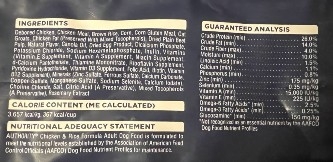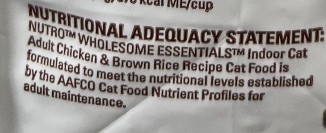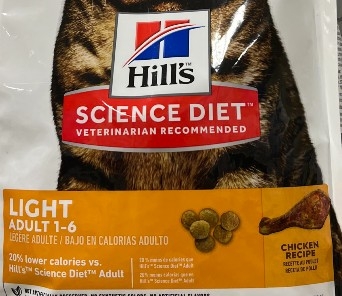A Consumer's Guide: Overview of Pet Food Labels
ID
FST-434P
EXPERT REVIEWED
Introduction
A pet food label contains a wealth of facts and information for the pet owner (consumer). These labeled facts and information are extremely useful to get the most out of the pet food. The goal of this document is to assist you, the consumer, to read pet food labels and understand what different terms mean.
Pet Food Labels
The Food and Drug Administration (FDA) and the Association of American Feed Control Officials (AAFCO) requires that all pet food products have the following:
- The Full Product Name
- Net Quantity Statement (i.e., how much product is in the container/package)
- Manufacturer's Name and Address
- The Ingredient List
- Guaranteed Analysis (i.e., or nutrient content)
- The Nutritional Adequacy Statement
- Feeding Directions
- Type of pet that the food is intended for (e.g., Cat, Dog)

Product Name
While a pet food product’s name may play a role in whether a consumer purchases the product, there’s more to the product name than just marketing or recognition. The product name specifies how much of an ingredient makes up a product. Even a minor change to the wording of the product name has a dramatic impact on the minimum amount of an ingredient required. The Association of American Feed Control Officials (AAFCO) has four rules regarding the wording of pet food products name :
The “95 Percent” rule: At least 95% of the product (by weight) must be the named ingredient; for example, the ingredients of “Salmon Cat Food” must include at least 95% salmon (not including water). When including water, the named ingredient still must comprise at least 70% of the product. So, in our “Salmon Cat Food” example, salmon should be the first ingredient listed, followed often by water, and then other components, such as vitamins and minerals. If the name includes a combination of ingredients, such as “Salmon & Tuna Cat Food,” the two named ingredients together must comprise 95% of the total weight. The first ingredient named in the product name must be the one of higher percent (%) weight in the product.
The “25 Percent” or “dinner” rule: The “25%” or “dinner” rule applies to products if the named ingredients make up at least 25% (excluding water used for processing) but less than 95% of the named product by weight. If water is included, the named ingredients must amount to at least 10% of the product by weight. Many descriptors other than “dinner” may be used including platter, entree, nuggets, and formula.
The “3 Percent” or “with” rule: The “3%” or “with” rule applies to products where the ingredients contained after the “with” only need to be 3% of the product weight, such as “Doggie Dinner with Beef” where beef amounts to 3% of the product weight.
The “Flavor” rule: According to the “flavor” rule, a specific percentage is not required, but the product must contain an amount sufficient to be detected. For example, in “Chicken Flavor Dog Food,” the ingredient may be chicken, but more often when named this way, it is another substance including chicken meal or chicken by- products, that will give the characterizing flavor or aromas of real chicken.
The product name can be a key factor in the consumer's decision to buy the product. Even a minor change in the wording of the name has a dramatic impact on the pet food composition. For example, a can of "Cat Food With Tuna" could easily be confused with a can of "Tuna Cat Food". However, whereas the former example only needs to contain 3% tuna by weight while the latter must contain at least 95% tuna by weight.

Nutritional Adequacy Statement
The nutritional adequacy statement on a pet food label allows the consumer (i.e., you) to determine if the pet food achieves the adequate nutrition for your pet. If this statement includes the phrase “complete and balanced,” then the product is intended to be fed as a pet’s sole diet and is nutritionally balanced (provides adequate nutrition to the animal for health lifestyle). Treats, snacks, and supplements are typically not intended to be a pet’s sole diet, so these products are labeled as not “complete and balanced”; indicating they are not intended to be fed as a pet’s sole diet.
To have "complete and balanced" in the nutritional adequacy statement, a dog or cat food must either:
Meet one of the Dog or Cat Food Nutrient Profiles established by the Association of American Feed Control Officials (AAFCO).
Pass a feeding trial using AAFCO procedures.
Additionally, since the nutritional need of each pet differs by life stage, AAFCO established two nutrient profiles for both dogs and cats:
One for growth and reproduction (i.e., pregnant, and nursing animals)
One for adult maintenance
Occasionally a product may be labeled for a more specific use or life stage (i.e., senior) or for a specific size. Currently no rules have been established to govern these types of statements.
Thus, a "senior" diet must meet the requirements for adult maintenance, but no more.

Decoding Pet Food Label Terms and Claims
This section is Intended to assist consumers In understanding what certain pet food label terms and claims mean. This is not an exhaustive list, for more information, see the Food and Drug Administration (FDA 2020b). In Virginia, you can contact the department of agricultural and consumer services division of animal and food at vastatevet@vdacs.virginia.gov
Premium or Gourmet are not required to contain any different or higher quality ingredients, nor are they held up to any higher nutritional standards, than are any other complete and balanced products. The use of premium or gourmet on a package is often just used as a marketing term.
"Natural" means the lack of artificial flavors, colors, or preservatives in the product.
Organic pet foods are required to adhere to the rules and regulations outlined by the U.S. Department of Agriculture (USDA) National Organic Program.
By-products is the left over ingredients after the intended product has been made. For example, meat by-products are the most common in pet food, and include organ meats and bones.
Lite, low-calorie, and low-fat are terms that describe a pet food that has a significant reduction of calories or fat, compared to standard pet food. The Association of American Feed Control Officials (AAFCO) requires that pet food labels making these claims must show the percentage reduction in calories or fats and must name a product for comparison.

References
Association of American Feed Control Officials (2012). Reading Labels. Available at:
www.talkspetfood.aafco.org/readinglabels
Center for Veterinary Medicine. (2018). Human Food By-Products For Use As Animal Food. U.S. Food and Drug Administration. Available at: www.fda.gov/regulatory-information/search-fda- guidance-documents/cvm-gfi-239-human-food-products-use-animal-food
Food and Drug Administration (2020a). “Complete and Balanced” Pet Food. Available at:
www.fda.gov/animal-veterinary/animal-health-literacy/complete-and-balanced-pet-food
Food and Drug Administration (2020b). Pet Food Labels – General. Available at:
www.fda.gov/animal-veterinary/animal-health-literacy/pet-food-labels-general
Virginia Cooperative Extension materials are available for public use, reprint, or citation without further permission, provided the use includes credit to the author and to Virginia Cooperative Extension, Virginia Tech, and Virginia State University.
Virginia Cooperative Extension is a partnership of Virginia Tech, Virginia State University, the U.S. Department of Agriculture (USDA), and local governments, and is an equal opportunity employer. For the full non-discrimination statement, please visit ext.vt.edu/accessibility.
Publication Date
October 5, 2022



